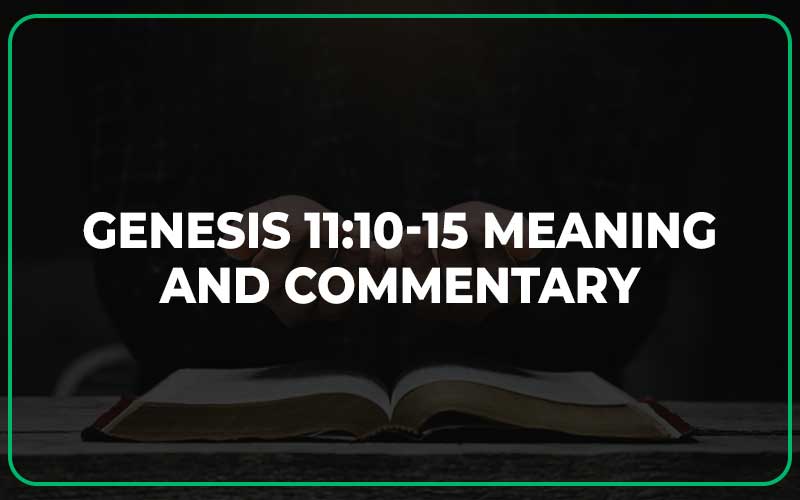Genesis 11:10-15
10 This is the account of Shem’s family line. Two years after the flood, when Shem was 100 years old, he became the father of Arphaxad. 11 And after he became the father of Arphaxad, Shem lived 500 years and had other sons and daughters.
12 When Arphaxad had lived 35 years, he became the father of Shelah. 13 And after he became the father of Shelah, Arphaxad lived 403 years and had other sons and daughters.
14 When Shelah had lived 30 years, he became the father of Eber. 15 And after he became the father of Eber, Shelah lived 403 years and had other sons and daughters.
Genesis 11:10-15 Meaning
In Genesis 11:10-15, we learn about the genealogy of Shem, one of Noah’s sons. These verses trace his lineage from Noah to Abram (later known as Abraham). It emphasizes the promises of God and the continuation of His plan to bless all nations through the descendants of Shem.
Genesis 11:10-15 Commentary and Explanation
In Genesis 11:10-15, we delve into the genealogy of Shem, the son of Noah, and gain insight into the post-flood lineage. These verses provide a critical bridge between the events of the great flood and the subsequent narrative that unfolds in the Bible.
Verse 10 introduces us to Shem, one of Noah’s three sons, and informs us that he became a father at the age of 100, two years after the flood. This chronological detail is crucial because it helps us trace the generations that follow. Shem’s son is named Arphaxad. This genealogy is essential in understanding the lineage leading to Abraham, the father of the Israelite nation. In fact, Luke’s Gospel (Luke 3:34-36) traces Jesus’ lineage back to Shem, highlighting the significance of this lineage in biblical history.
Verse 11 tells us that Shem lived for an impressive 500 years after the birth of Arphaxad, during which time he had other sons and daughters. Shem’s longevity reflects the longer lifespans of individuals in the pre-flood era, a characteristic often noted in genealogies throughout the early chapters of Genesis.
In verse 12, we learn that Arphaxad, Shem’s son, became the father of Shelah when he was 35 years old. This verse emphasizes the continuity of the family line and the passage of time. Arphaxad, like his father, also had a significant lifespan, living for 403 years, and had additional offspring.
Continuing with verse 14, we see that Shelah, Arphaxad’s son, became a father at the age of 30 when he had a son named Eber. The genealogy is reiterated as we learn that Shelah, like his forebears, lived for 403 years and had other sons and daughters during his life.
These verses may appear to be straightforward genealogical records, but they serve a more profound purpose in the biblical narrative. They connect us to the past, allowing us to trace the lineage from Noah to Shem, and eventually, to Abraham, Isaac, and Jacob, who played pivotal roles in God’s covenant with the Israelite nation. This lineage ultimately leads to the birth of Jesus Christ, as confirmed in the New Testament (Matthew 1:1-17 and Luke 3:23-38).
Overall, Genesis 11:10-15 serves as a foundational part of the biblical narrative, connecting the post-flood era to the generations that follow. It highlights the continuity of God’s plan through the descendants of Shem and, in the broader context, points to the fulfillment of God’s promises in Jesus Christ. These genealogical records are more than just a list of names and ages; they are a testament to God’s faithfulness and His intricate plan for humanity’s redemption.
Also Read: Genesis 11:5-9 Meaning and Commentary
Context of Genesis 11:10-15
Genesis 11 follows the account of the Tower of Babel, where God confused the languages of the people and scattered them over the earth. This scattering resulted in different nations and languages being formed. In this context, the genealogy of Shem signifies a shift in focus from the general history of mankind to a specific family line that will play a crucial role in God’s plan.
Lessons From Genesis 11:10-15
God’s plan continues through generations: Despite the sinful nature of humanity, God’s plan remains steadfast. The genealogy presented in these verses showcases the continuity of God’s promises from one generation to the next. It reminds us that God’s providence is at work in shaping history.
God’s timing is perfect: The ages mentioned in these verses may seem arbitrary to some, but they serve to remind us of God’s sovereignty over time. Each generation is a part of God’s unfolding plan, and He works in His perfect timing to bring about His purposes.
Our lives are interconnected: Just as the lives of the individuals in this genealogy are connected, so too are our lives interconnected with others. We are not isolated beings but part of a larger narrative. Our actions and choices can impact future generations, so it is essential to live faithfully and obediently before God.
Value of Genealogies: These verses remind us that genealogies serve a purpose in God’s plan, connecting us to a larger narrative of redemption. They remind us of the importance of our family history and heritage.
God’s Faithfulness Through Generations: God chose to work through a specific family line, starting with Shem and ultimately leading to Abraham. This demonstrates that God’s promises and blessings can pass through generations, and He remains faithful to His covenant.
Also Read: Genesis 11 Meaning and Commentary
Final Thoughts
These verses highlight the significance of Shem’s lineage in the narrative of God’s redemptive plan. God’s promises to bless all nations through the descendants of Shem find fulfillment in the birth of Abram. As we reflect on this genealogy, may we be reminded of the importance of faithfulness, the sovereignty of God’s timing, and the interconnectedness of our lives. Let us trust in God’s providence and live in a way that aligns with His eternal purposes.

